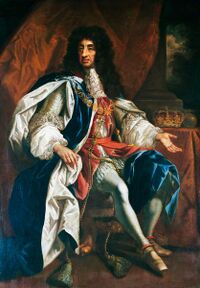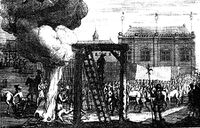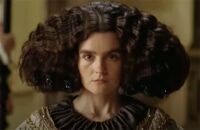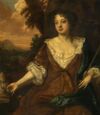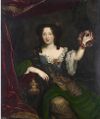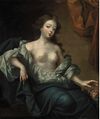King Charles II
King Charles II (to his girlfriends, Randy Charlie) ruled England, Scotland and Ireland from 1660 to 1685. He is also known as the Merry Monarch, as he was always drunk on rum and sherry. Charles was devious, treacherous and a demon when it came to wenches, whether high- or low-born or somewhere in between. He founded the Royal Society in a pretence to be intellectual.
In the Americas, he was known as Caroline and got two U.S. states named after him because it sounded regal. Eventually, the name was reserved for females, Charles' long hair surely confusing the colonials, then later, reduced to something to sing at baseball games, though this Caroline was hardly Sweet. Charles did know how to have fun — at your expense.
Early life[edit]
Charles's father was King Charles I. In 1649, when killjoy Republicans removed his father's head, Charles said it was his turn to be a merry monarch. However, Oliver Cromwell said, 'Not so fast.' Charles had support from Royalists, but Cromwell unfairly beat them down everywhere. This forced Charles to live in trees (favouring oaks) and hide amongst friends until he had eaten them out of house and home. Charles then moved to Holland to grow his hair even longer. There he sponged off his sister Mary, who had married William the Tangerine, grandson of William the Silent and father of William of Orange.
Oliver Cromwell became a dictator as Sheath Lord Protector and abolished both the republic and Christmas. He hoped the Dutch would eventually send Charles back, but the First Anglo-Dutch War broke out, so all deals were off.
Restoration[edit]
When Oliver Cromwell died in 1658 from excessive warts, England etc. fell into confusion. Oliver's son Richard Cromwell, the Sheath Lord Protector, was shunted off the throne. Cromwell's General George Monck took control and sent an invitation to Charlie to return across the English Channel for some serious 'Monckey' Business. This pleased Charles, who found the Dutch people boring and saw a good excuse to avoid paying his back rent for a windmill he was living in.
Charles's return to London was treated like a Second Coming. The new king promised he would forget everything that happened over the past 20 years and would be merciful and merry at the same time. In the meantime, people could take revenge on Oliver Cromwell's corpse. The former Sheath Lord Protector was pulled out of his coffin in Westminster Abbey and hung on a gibbet. Cromwell's head was then removed and stuck on a spike on Westminster Hall, where Charles' father Old Charlie had gone on trial and had been condemned.
Son Richard Cromwell had already fled the country, but other old friends of Oliver were soon exposed to the full mercy of England's treason laws. People were merry as they watched fellow human beings being taken apart on a scaffold with just their heads left to be mounted in various amusement parks.
Marriage[edit]
Although already fathering at least one son (James) while in Dutch exile, protocol now required that Charles take a foreign princess. Protocol may have been the impetus but the theme was alcohol. Charles's own mother had been a French Bourbon and aunt to King Louis XIV. Being a Catholic was no big deal, so Charles hoped for a nip of a Spanish or Austrian Habsburg, but was disappointed. Instead, his ministers settled on a deal with Portugal. Charles married Catherine of Braganza (a strong cordial). She was funny and awkward and spoke English with a little girl's voice. Though Charles did his royal duty in the marriage bed, none of their children survived long enough to get a name.
Girlfriends[edit]
Charles collected women like diamonds; his tastes in women were broad, as it were. In fact, no woman was safe in his company. Fortunately for him, there was no #MeToo nor any other hashtag in the 17th century. Charles's ladies were rewarded with titles, lands and palaces if they amused him. Many of their offspring ended up in the House of Lords. Here are just a few of them:
- Lucy Walter.
Also known as Loose Lucy. Took the king's cherry. Served beer in a Dutch bawdy house. Died suddenly before Charles left Holland. Very suspicious.
Their only son James was given the dukedom of Montmouth. He lost it and his noggin for rebelling against Uncle Jimmy when the latter became King James II.
- Barbara Villiers.
Her family — the Dukes of Buckinghams — got their lands and money restored by providing King Charles with his longest encumbered mistress. For 25 years, Barbara stood beside Charles, and lay beneath him for even longer.
Barbara gave birth to five children, all begotten and provided for by the monarch. By now, half the peerage of England were products of Charles's loins.
- Louise Renée de Penancoët de Kéroualle.
French spy. Aristocrat. Made Duchess of Portsmouth for services rendered in and out of bed. Said to have bedded a lot of the English and French nobility. Known also as the 'Catholic Whore' but not to her powdered face.
King Louis XIV gave her the title of Countess of Bisoux and a topless beach in Cannes. The latter still exists.
- Nell (Eleanor) Gwyn.
Charlie's favourite tangerine squeeze. Called herself the Official King's Protestant Whore.[1] Her son Charles became Duke of St. Albans and Groping.
Nell was said to be as common as muck, illiterate and willing to pose naked for painters with randy commissions. Died shortly after Charles when oranges were banned as a political symbol for the Dutch William.
- Catherine Pegge.
The original peg leg. Charles found her 'interesting'. The leg was screwable, in both senses.
Catherine was also known as 'Peggy' and 'Mary'. A bit more common than Nell Gwyn even.
- Moll Flanders.
Wrote a tell-all book about bedding the king. 'Flanders' was also slang for the 'Nether Regions' or the groin. Her veracity was challenged and, in any case, the reader never learns if Flanders Fields are shaved.
King Charles had so many mistresses that their sum total is not recorded. It's a surprise the king had any energy outside the bedroom. Moll was his last recorded squeeze.
Dutch wars[edit]
Another institution absent in the 1600s was the tabloid press. Consequently, none of Charles' amorous adventures made Page Three. Charles looked for other ways to cheaply titillate his fellow Englishmen and bolster his popularity. Remembering his days in exile in Holland clog-dancing with mice for spare change, he opened a trade war against the Dutch. Now, starting a trade war with these master merchants would be like starting a Hawaiian-shirt war against Americans, but Americans didn't yet exist either, so Holland it was.
In 1664, James, Duke of York commanded the navy to cross the Atlantic and sail into the harbour of New Amsterdam. The men took the settlement without firing a single musket and gave it the more proper name of New York. The Dutch governor, Peter Stuyvesant, who had bought Manhattan from the locals for a packet of cigarettes, stayed on rather than return to Holland and face living out his life as a national scapegoat.
When word of the loss of the North American outpost went back across the ocean, the Dutch were mightily insulted. They responded with the Second Anglo-Dutch War, also known as the War of the Cheeses. Edam thrusted and parried against cheddar. Fortuitously for the Dutch, the English were beset by the Great Plague in 1665, the Great Fire of London in 1666, and an outbreak of Bangers and Mash in 1667. Surely God was a Calvinist and meant to deal a blow to the bawdy English king and his Catholic wife.
In 1667, the English ran out of money and economised by anchoring their fleet in the River Thames. This made it easy for the Dutch to attack. They towed King Charles's flagship (the H.M.S. King Charles, naturally) back to Holland.
That got Charles's attention; he stopped chasing women long enough to sign a peace treaty with the Dutch. The war had gained them New York, but that was it. London was still a ruin and Charles was still heirless. His brother James had married but had no son, only two daughters. And both were homely.
An Orange man[edit]
Charles still nursed hard feelings towards the Dutch government. They were, after all, Republicans and had rejected Charles's nephew William as their leader (or StudHolder). To change Dutch minds, Charles devised a secret alliance with King Louis XIV that would guarantee Louie a pension and 'other rewards' if he supported a war against the Edam-eaters.
The Dutch manned a series of forts along the border between France and the Spanish Netherlands, but the French army bypassed them all and attacked the Dutch by land. With English support, the combined force seemed insurmountable. Blamed for the defeats, Dutch leader Johan de Witt was torn apart and eaten by the mob. They had his brother Cornelius for dessert. Now entirely Wittless, the Dutch deployed their ultimate weapon. With the battle cry, "Get your finger out!" they opened the dikes and deliberately drowned their own country in dirty water and mud. To reinforce the impression that Holland was not worth conquering, Dutch rebels then chose William of Orange as their new leader. Charles got cold feet about continued battle and instead dangled a marital alliance with William via his niece Mary.
Charles's other alliance, with Louis XIV, was increasingly unpopular with England's anti-Catholics. Charles's brother James had already come out and, if anything untoward happened to Charles, the rules of succession would saddle England with a Catholic king. Ew! James's supporters were called Tories (Irish for brigands) whilst those opposed to him were known as Whigs for their permanent bad-hair days. The country's major political parties still wear these insults with honour.
Titus Oakes[edit]
It was in this atmosphere that a 17th-century version of Joseph McCarthy emerged. Titus Oakes told the nation, "I have in my pocket a list of Papist conspirators!" These included Samuel Pepys (he of the diary) and Queen Catherine. He claimed they were working with James to kill King Charles. The Whigs in Parliament supported Oates and effectively appointed him Conspiracy Detector. For the next three years, people were imprisoned and executed on flimsy or nonexistent evidence.
Eventually, Oates overreached and suggested King Charles himself was in on the Popish Plot — assassin and victim all in one. This burst the bubble. In 1681, Charles dismissed Parliament and had Oates whipped through the streets of London. Recalling his father's management style fifty years earlier, Charles never did reconvene Parliament but filed his own motions and amendments, and voted them into law himself. The result was a turnabout against the Whigs. Now, it was their leaders who went on trial or were exiled or executed.
Death[edit]
Charles died in 1685. He left his clothes to his various mistresses and wigs to his brother. Close to death, Charles revealed that he had been a secret Catholic for years. So bleep you, Anglicans. His death was as merry as his life had been, unless you were a Whig.
References[edit]
- ↑ A paid post in the British royal household. Last held by Camilla Parker-Bowles — now Queen Camilla.
